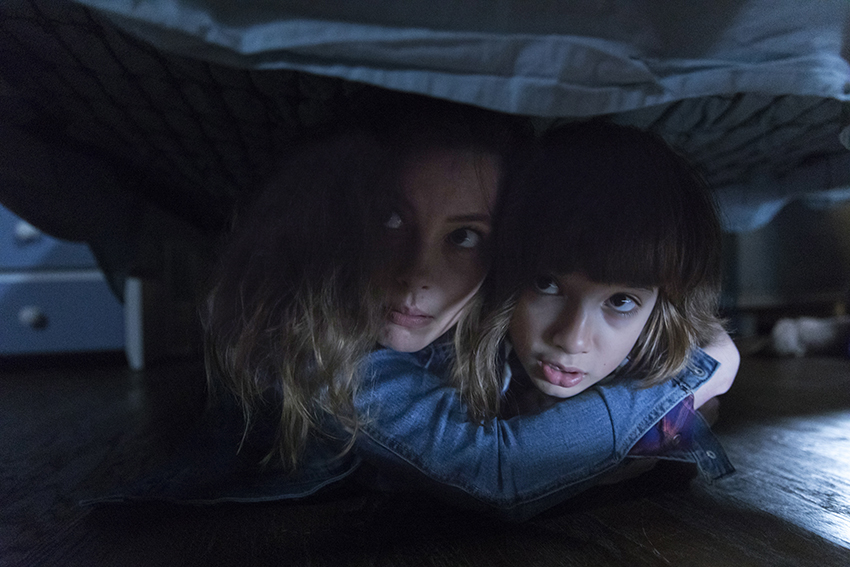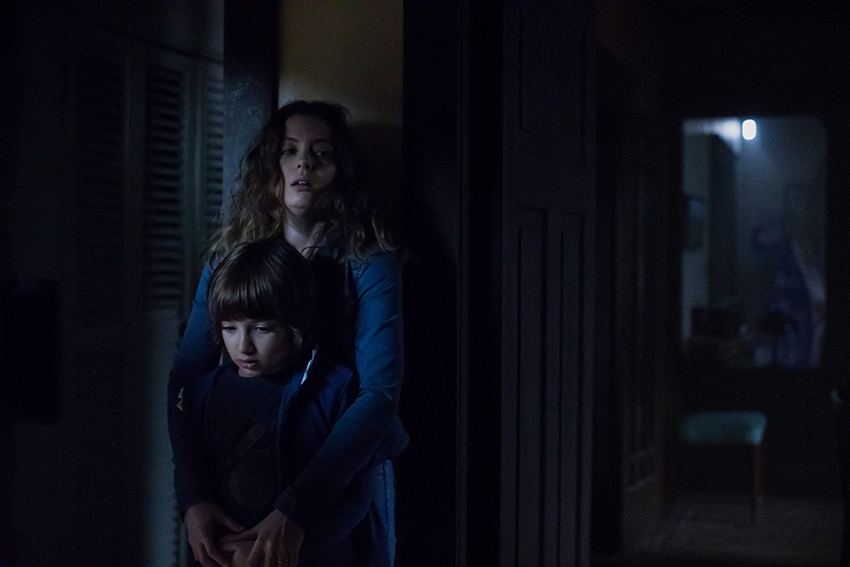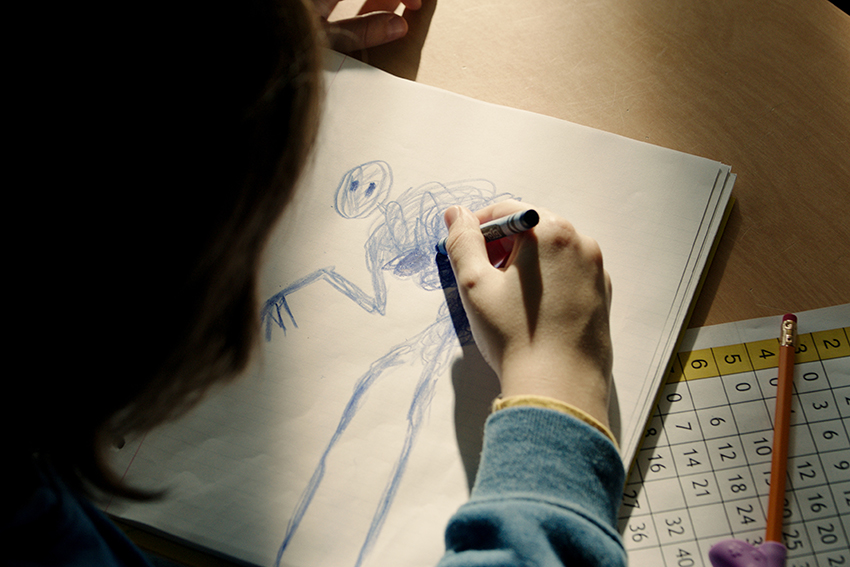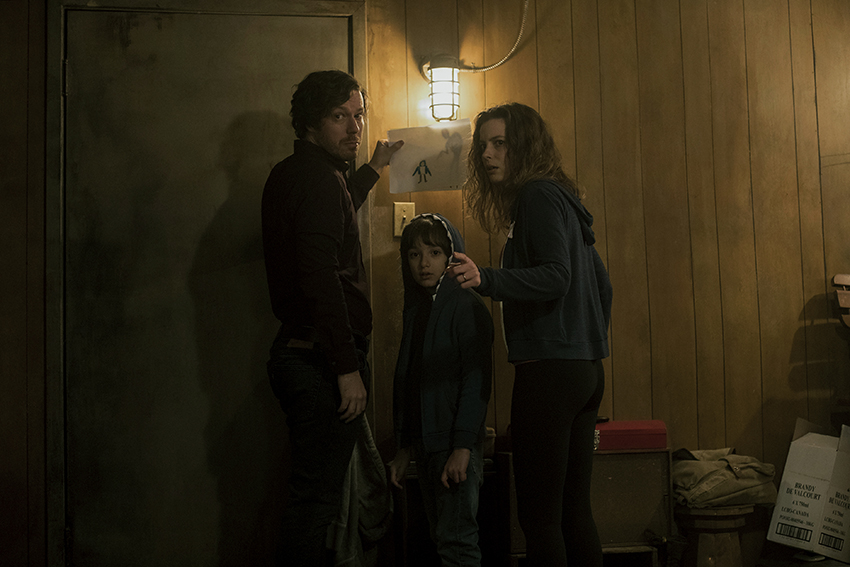Movies - Come Play : Focus on a great and new horror movie
By Mulder, 31 october 2020

Based on his short horror film, Come Play is written and directed by Jacob Chase. The Picture Company’s Alex Heineman (A Million Little Pieces, The Gunman) and Andrew Rona (A Million Little Pieces, The Gunman) produce. Alan Blomquist (Book Club, A Dog’s Purpose) serves as executive producer. Production designer David Bomba (A Million Little Pieces, Mudbound), director of photography Maxime Alexandre (Shazam!, The Nun), costume designer Marcia Scott (Downsizing, A Simple Favor) and editor Gregory Plotkin (Get Out, Happy Death Day) complete the creative team. This powerful story about love and friendship stars newcomer Azhy Robertson (Marriage Story, Juliet, Naked), Gillian Jacobs (Love,Community), and John Gallagher Jr. (10 Cloverfield Lane, Hush), and co-stars Jayden Marine, Winslow Fegley, and Gavin MacIver Wright.
Jacob Chase’s fascination with horror began as a child with live haunted attractions. He remembers begging his mother to take him to Universal Horror Nights when it first opened. “I went in through the first door and was crying so hard I said, ‘Get me out of this, I have to go,’ and Mom took me out through the emergency exit,” recalls Chase. “The next day I had to go back and became hooked on the feeling of being terrified.” Halloween became such a favorite that he eventually started a business making his own haunted houses with friends. His experience with haunted houses was instructive. “I learned so much about what it means to create suspense in a live atmosphere and then brought that experience into the film world.”
After making a series of short films with friends, Chase had a career breakthrough when he won the 2016 Doritos’ Crash the Super Bowl ad contest with “Doritos Dogs.” His commercial aired during the Super Bowl, earned him an exclusive directing mentorship under Zack Snyder on the set of Justice League, and Jacob used the prize money to finance a short film called Larry.
Chase’s inspiration for the short came from his love of complicated antagonists. “I had this idea for Larry, a monster who’s lonely and all he really wants is a friend but goes about getting one in very scary ways.” The short also explored the connection between technology and loneliness. “That aspect of it is very closely tied to Larry because he’s a monster that comes from loneliness, and technology can be amazing but the way we use it can also lead to loneliness,” adds Chase. “It made sense to me that Larry was a manifestation of our modern technology.”

Chase wanted to make a genre film using today’s tools. “Technology plays a huge part in this film because it’s around us everywhere,” says Chase. The challenge was how to take what works in horror movies and update it. “It’s not about someone hacking you or about weird coding,” continues Chase. “It’s essentially the new delivery device, with the tablet and phone as the new version of the haunted house.”
Chase’s short came to the attention of Alex Heineman and Andrew Rona, producing partners in The Picture Company, who are big fans of high concept genre movies. “Looking at the short film, we knew that Jacob had a real vision and that the short needed to be turned into a movie,” says Heineman. The producers were particularly impressed with the way Chase blended aspects of horror with technology. “His use of technology didn’t feel forced or make the short entirely about technology; it was just a component of the story he was telling.”
Chase attended his first meeting with the producers armed with an outline for a feature version of what would become Come Play. The expanded story centered on Oliver, a friendless young boy on the autism spectrum, who connects with Larry via his devices. It also established a rich emotional core by introducing Oliver’s parents, Sarah and Marty, and expanded on Larry’s origins and his motives. These details confirmed Heineman’s initial impression about the short’s potential, and he and Rona decided to begin seeking production partners.

Their first instinct was to reach out to Steven Spielberg’s Amblin Partners. As Heineman explains, “Amblin produced Goonies, the original Poltergeist, and Gremlins. Also, Steven Spielberg is the one who is really responsible for creating this genre in a way, especially horror movies with a family component. We have a strong relationship with Amblin and immediately thought this would be a perfect film for them,” For Chase, there couldn’t have been a more perfect collaborator. “I grew up on Amblin movies and they weren’t afraid to scare children,” explains Chase. “And so, the idea of making a film that’s scary for both children and adults, it just felt like there was no better place. And of course, the idea of working with Steven Spielberg is absolutely insane.”
Alan Blomquist joined the team as executive producer and, with the other filmmakers, started to assemble the creative team to support and execute Chase’s vision. Production designer David Bomba was an early and easy pick. During their first conversation Bomba and Chase were both intrigued by the potential for their collaboration. Chase liked Bomba’s ideas about how to infuse reality into the story. “He took my concept for this whole world and had incredible ideas of his own of how to bring it to life,” he recalls. Grounding the film in the quotidian details of ordinary life was essential, Bomba adds. “If we want to believe this story about a fantasy creature, then everything else in that world - the school, the house and the field - has to be real. That allows us to accept the idea of Larry.”

Chase was already familiar with the work of director of photography Maxime Alexandre, whose credits include Annabelle: Creation and Maniac. “Maxime has shot a lot of my favorite horror movies of the last 20 years,” says Chase. “He’s an incredible DP and so I was super stoked to get him.” Chase, Bomba, and Alexandre all agreed that Come Play is a story about real people dealing with an otherworldly creature, and that the fantastical elements needed to be balanced with reality and proceeded planning to make it work.
One of the first decisions made was to build Oliver’s house as a set on a soundstage. That enabled Bomba to design according to Chase’s script rather than having to adapt the script to a practical location. “We were able to actually build what I was imagining,” Chase comments. “I was able to explain to David all these very specific blocking moments in the script and then he designed the blueprint for this incredible house. It’s exactly like what it was in my head - only better because David did it.” Blomquist adds, “It allowed us to have more flexibility and functionality by creating a layout that took into account the space the crew and puppeteers would actually need.”
Chase’s experience making haunted houses was evident in Larry’s appearance in the short. “I made Larry as a half puppet, half costume thing because I was used to making practical props, puppets and monsters,” he recalls. “It ended up working really well because it felt like Larry was there in the environment with the main character in the short.”

Chase wanted Larry to be a physical presence in the feature, but as Heineman explains, that is not usual industry practice. “In a lot of movies like this, the Larry creature would be done with all visual effects, and that has become the standard.” However, the producers recognized that CGI wouldn’t do in this instance; a three dimensional Larry was necessary to impart the immediacy and physicality Chase was seeking for the feature. Moreover, a practical effect would be a boon for the cast. “Having that physical being to act off is valuable, especially working with kids.”
Executive producer Alan Blomquist agrees. “It’s like having another actor to act against in a scene rather than a tennis ball on a c-stand. So, there’s something to be said for having Larry be real, and we knew if it worked out, it would also be less expensive than having to create Larry entirely from computer generated shots.” Chase and Blomquist met with a number of companies before choosing The Jim Henson Creature Shop to create and build Larry as a tactile creature. Chase explains, “They’re known for the best puppetry in the world and can create emotion and really bring a character to life through puppetry.”
Functionality guided the creative process, according to Russ Walko, member of the Henson build team and the lead puppeteer during production. “We were figuring out, from the beginning of the build, how he’s going to need to move based on a script and by talking to Jacob throughout the whole process,” explains Walko. The Henson team also relied on sketches, storyboards and skeleton charts to determine how Larry would be used in each scene and to adjust the design accordingly. “Having storyboards really dictates what they’re expecting to see,” continues Walko. “A lot of puppeteering is being able to hide and provide the performance within the frame, while being able to have our whole operation working underneath and around the side of the frame.” Mobility was another major consideration. “Larry dictates how he moves,” says Walko. “Just the fact that he’s nine feet tall means he can’t do as much as a human. There’s this odd, weird movement he has that’s not human even though he’s basically proportioned as a human.”
Constructed with aluminum rods, latex and foam rubber, Larry has a spring spine to allow for movement from left to right, and up and down. Given his size it wasn’t possible to operate Larry with a hand in the head. Walko recounts. “In some scenes, we’re puppeteering through walls. So we had to be able to move him as much as possible and be flexible with what he needs to do on set. And we had to be able to do it at distance when necessary.” Frequent testing let the Henson team and filmmakers see what was possible. The results allowed Chase to fine-tune and make changes to the script. In one instance the puppeteers had Larry duck under a doorway and realized that he would have to crouch for it to happen. “We showed Jacob and sure enough, he wrote it in the script,” recalls Walko. “So, there was a lot of what he wanted and giving him what we could provide and finding what works for all of it.” “It’s really incredible what the creature became,” explains Heineman. “I can’t wait for everyone to see it.”
Larry uses electronic screens to access the human world in search of a friend. The target of his attention is an equally lonely, non-verbal eight-year-old named Oliver on the autism spectrum. The search for an actor for the role of Oliver was extensive, but Azhy Robertson sparked early interest, after a recommendation from Steven Spielberg brought him into the audition process. “Azhy read for the role and we immediately responded to him. We saw a lot of different kids for the role, but his performance and the way he captured the story made us sure that he was Oliver,” states Heineman. The filmmakers were looking for a child with a specific demeanor and sensibility; someone who could convey emotion without speaking. Robertson’s expressive eyes tipped the scales in his favor. Chase comments, “You can read so much from his eyes, especially for a character that doesn’t talk. I couldn’t have asked for a better actor to play Oliver.”

Robertson’s interest was heightened by the film’s focus. “It’s about a kid with autism, and most movies don’t have a main character who has autism.” To help Robertson prepare for the role, Chase worked out a sliding scale breathing exercise to illustrate Oliver’s reaction when upset. “One is mildly calm breathing. Five is pretty stressed. Seven is really, really stressed, and so on,” explains Robertson. The young actor’s reference material included Amblin’s Poltergeist, which he watched with his father. Robertson also prepared for the role by spending time with children who are on the spectrum, at their special-needs schools in Rhode Island and NYC, and working with movement and speech coaches to ensure accuracy in his performance.
Gillian Jacobs took on the role of Sarah, Oliver’s mother, though she readily admits to being scared of horror movies. “I felt like this movie was in the great tradition of Amblin films and I really wanted to be a part of it,” she comments. “I thought it was an incredibly imaginative and emotional script. Jacob told a story about parent/child dynamics and common feelings like loneliness, which are externalized in this character of Larry”. Heineman describes Sarah as “a great role because this character really gets to do a lot emotionally. At the start of the movie she’s going through a separation. She’s having issues raising her son. When Larry enters the picture, it’s a whole other issue that she has to grapple with. Gillian has the inner strength and resilience we felt the role needed. That’s why we chose her.” Chase agrees. “Gillian really brought a warmth to the character,” he remarks. “People have flaws, and Gillian has been incredible at taking Sarah’s flaws and still making her endearing and relatable.”
John Gallagher Jr. plays Oliver’s father, Marty. “Marty is the fun-loving dad and the bright spot for Oliver day-to-day. But through the course of the movie he realizes he needs to be there more for his son and not just to have fun, but also in the hard stuff and by being a better parent,” offers Heineman. “John brings the fun nature to Marty we wanted the character to have. Even in little moments when there’s no dialogue, he always has a great look or a reaction to stuff,”
Gallagher is a big fan of horror films and he came to the project with strong memories of the films he enjoyed as a child. “I was excited that this was an Amblin film,” he says. “A lot of those movies were really vital and important to me when I was a kid and I feel Jacob is continuing in that tradition with this film. It’s really grounded for a movie as heightened and scary and exciting and adventurous as it is.” He likens the appeal for horror to a rollercoaster ride. “You’re putting yourself into a situation where your adrenaline gets going but know you can turn it off and you’re going to be safe.”
Chase was delighted with the casting of Jacobs and Gallagher. “This was such a dream come true for me because both John and Gillian are known for being humorous,” he explains. “So, getting to put them in a movie where I got to scare the crap out of them, and got to see them in a whole new light, was absolutely a joy for me.”
At the start of Come Play, the Sutton family is in turmoil. By the end of the film, they emerge with a newfound hope for their future. As Gallagher describes it, “There is a lot of redemption in our story. Everybody gets through this larger-than-life scenario of having to literally do battle with an entity but on the other side, everybody gets a second chance, another lease on life.”

Larry is drawn to Oliver because he can sense his loneliness. Oliver’s inability to communicate and connect socially results in him being bullied at school. During the search for Oliver’s erstwhile friends and bullies, the filmmakers would often audition groups of boys together. “When I was casting, I wanted to make sure they all felt like a unit that had been friends for a long time,” explains Chase. They eventually selected Jayden Marine as Mateo; Winslow Fegley as Byron; and Gavin MacIver-Wright as Zach. Group dynamics are very much at play when it comes to the trio’s treatment of Oliver. As Marine says of his character, “Mateo follows Byron. So, if Byron’s bullying Oliver, Mateo is obviously going to do it as well. He doesn’t really know he’s being a bully. He’s just trying to have a good time with his friends.” To ensure that the friendship between the boys would be believable on screen, Chase arranged for them to go on group field trips before they started production.
Chase prevented Robertson from seeing the Larry puppet until their first scene together, so he could get the actor’s genuine reaction on camera. “Larry wasn't really what I was expecting but he genuinely creeped me out,” says Robertson. Gillian Jacobs had a similar response. “The first time I saw Larry was in the woods at night. They had him hiding partially behind a tree so I didn’t notice him at first. Larry is terrifying. He has very scratchy nails, too, and it’s not nice when he holds your hand.”
The puppet’s arrivals on set were met with excited and expectant folks, who wanted to see him being assembled and in action. The puppet required a team of three, and sometimes four, to operate and direct its movements, and presented Alexandre with a technical challenge to reduce the impact of their shadows and manage the dark tones. Watching Alexandre find creative solutions reminded Chase of making films with his friends in high school and college. “Maxime’s shot so many great movies but he’s not jaded; he still brings joy to every shot we do and is constantly elevating the horror of what we’re creating by merging mine and his ideas together.”
Chase was also impressed with Bomba’s use of tiny details in the house to enhance the scare factor. “David does these very subtle things with the wallpaper, for instance. It’s aged a little bit and seeing it in the background of a frame helps you feel like you’re in a scary movie and a scary environment.” Chase’s cast and crew are equally complimentary of him. “Jacob had done several short films and commercials, but on this movie, he really became an impressive leader, filmmaker, and artist,” comments Heineman. “Jacob is decisive but not inflexible,” adds Blomquist. “He is always willing to hear how his ideas can be made better by his team.”
Alexandre agrees. “Jacob is able to use the experience of those around him without losing his own line.” He was also struck by Chase’s gift for working with the young cast. “The way he talks to the children is absolutely magnificent. You need a lot of passion to work with children.” The friendship forged by the young cast in the lead-up to production was very evident on set. “Sometimes it was hard to get them apart because they were having such a good time screaming, laughing and making fun of each other, and talking about video games,” recalls Chase.

Robertson made a big impression in his first leading role. “Azhy’s able to articulate so much emotion without dialogue. He’s amazing as Oliver. It was been great to see that part come to life,” says Heineman. Robertson and Jacobs spent a lot of time together. “Azhy is so imaginative and fun,” Jacobs says. “I love hearing his opinions on books, movies, comic books, and food. It was really amazing to watch him go from being a kid to being totally committed to a scene and giving an incredible performance. He was a great pleasure to be around.”
The parking booth scene from Chase’s short is revisited in Come Play. Gallagher saw the original and was proud to be involved in recreating it for the feature. “Jacob shot it about a year ago before for no money and in one night, and here we are because of the quality of that short,” he enthuses. The parking lot scene was also the first time Gallagher saw Larry the puppet. “I came back from a break to see this giant massive creature inside the booth from afar, and the lights were off, and it was extremely creepy,” he recalls. “It made me feel like a kid again, and I’m really excited to gauge the reactions of everyone once they see it.”
The filmmakers are hoping that Larry’s adventure in search of a friend will bring both screams and tears from audiences. For cinematographer Alexandre, “There’s not a precise recipe for the perfect horror. After doing so many horror movies, I believe that the best types bring the audience where they don't expect to be. Basically, we guide them into one direction, and then, push them to get lost. And that’s the best step.”
Synopsis :
Newcomer Azhy Robertson stars as Oliver, a lonely young boy who feels different from everyone else. Desperate for a friend, he seeks solace and refuge in his ever-present cell phone and tablet. When a mysterious creature uses Oliver’s devices against him to break into our world, Oliver’s parents (Gillian Jacobs and John Gallagher Jr.) must fight to save their son from the monster beyond the screen.
Come Play
Written and directed by Jacob Chase
Produced by Andrew Rona, Alex Heineman
Based on the short movie Larry by Jacob Chase
Starring Gillian Jacobs, John Gallagher Jr., Azhy Robertson, Winslow Fegley
Music by Roque Baños
Cinematography : Maxime Alexandre
Edited by Gregory Plotkin
Production company : Amblin Partners, The Picture Company, Reliance Entertainment
Distributed by Focus Features
Release date : October 30, 2020 (United States)
Running time : 96 minutes

Photos : Copyright Focus Features
(Source : production notes)

